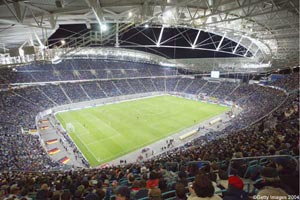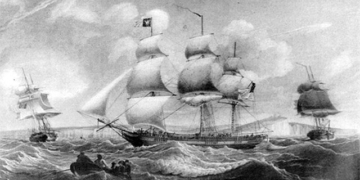No previous World Cup has demanded as much in terms of technology and infrastructure as this year’s tournament. Sponsors of the World Cup and FIFA’s technical partners, such as Avaya, Telekom, and Toshiba, have played a significant role.
“The entire organization process is supported by numerous interconnected information systems, allowing everyone to log in at all relevant locations,” explained Ralph Dietz, head of technology and telecommunications for the Local Organizing Committee (LOC).
 |
|
The lighting system at the stadium for the 2006 World Cup. Photo: CNet |
The applications used for organizing the tournament are grouped under the concept of “Event Management System“, which includes granting press credentials, managing transportation, handling documentation, material logistics, and operational plans for approximately 15,000 volunteers, as well as match result services…
“Another important technological task is to network the media centers, equip the press working areas, electronically check stadium entrances, establish ISDN and VoIP phone systems, provide broadband internet access, and implement traffic guidance systems“, Dietz summarized the IT requirements.
The Role of Sponsors
Toshiba provided all the laptops for FIFA employees, LOC, and volunteers. Avaya is the converged network management company that supports voice and data transmission within the venue and connects them all, while Deutsche Telekom is responsible for the metropolitan area network and information connectivity. Additionally, Deutsche Telekom installed and operated the technical infrastructure for media workspaces.
Philips distributed RFID chips for 3.2 million entry tickets, illuminated 8 out of 12 stadiums, equipped LCD screens for the media center, press stands, and many large screens throughout the city. Yahoo operated the official World Cup website www.fifaworldcup.com and the media communication channel.
Time Pressure and Network Connectivity
The biggest challenge for IT professionals at the 2006 World Cup was building the complex converged network system in a very short time. Since all tournament stadiums were part of the regular Bundesliga season schedule, the organizers couldn’t alter the technology infrastructure before the final match day. “We had less than 2 weeks to construct and operationalize the entire network“, said Karsten Hobbie, Project Manager for FIFA’s Network at Avaya.
Another challenge was the large number of locations that needed to be networked. “We had to connect about 70 locations, equivalent to a large enterprise with multiple offices having different requirements“, Hobbie stated. These areas included 12 stadiums, voice and data networks, the International Media Center, FIFA and team hotels, the “Welcome Center” at the train station and airport, FIFA’s IT control center in Munich, and the data center in Bamberg, which is responsible for FIFA’s Event Management System…
Deutsche Telekom’s subsidiary T-Systems used Asynchronous Transfer Mode (ATM) to connect the sites. “FIFA demanded quality in voice and data networking that exceeds that of corporate customers“, emphasized Udo Grossecappenberg, project coordinator at T-Systems.
Network Setup for the Media
The organizers anticipated around 15,000 media representatives (journalists and technical staff) from around the world to cover the World Cup. Therefore, T-Systems installed Internet connectivity at press stands, in studios, and various other media areas with a speed of 2 Mb/s and 30,000 ISDN phones. Additionally, T-Systems, together with Avaya, established a VoIP network for FIFA with about 3,000 phones throughout Germany.
Cable TV Signals
The International Media Center (IMC) in the exhibition area of Munich is divided into the International Broadcasting Center (IBC) for audio-visual media and the Main Press Center (MPC) for journalists. For the first time, signals from the stadium were transmitted via fiber optics to the broadcasting center IBC to satellites, reaching countries around the world.
The optical fiber system provided by T-Systems has a capacity of 155 Mb/s. The 2006 World Cup was also the first sporting event to allow images to be transmitted in digital DHTV (High Definition Television) format with a 16:9 aspect ratio.
Entry Tickets Using RFID
To prevent counterfeiting and black market tickets, all over 3 million World Cup tickets are equipped with RFID chips from Philips. These chips do not contain personal data but are a form of encryption. Upon entry, the reading device sends the information stored in the chip to a central computer for comparison with the database. Thus, within seconds, the system can confirm whether the ticket is valid, eliminating the need for manual checks of each ticket.
| IT Infrastructure for the 2006 World Cup |
|
500 – 600 switches were assembled in the stadiums. 15,000 km of copper cable were utilized, with a total length of 1,000 km. 4,500 devices were connected to the converged voice and data network, including approximately 3,000 IP phones. 10,000 flat screens ranging from 16 to 50 inches were provided for reporters and media. Large screens in the city ranged from 60 to 200 m². “Smart” traffic guidance systems in the city help drivers find the fastest route to the stadium and the nearest available parking spots. The COX (Communication and Orientation eXpert) system operates on phones and mobile devices capable of receiving GPS, GMS, GPRS, WLAN, and Bluetooth signals. Through COX, attendees can select the most scenic, quickest, and most economical route to the stadium. |
Phan Ba


















































